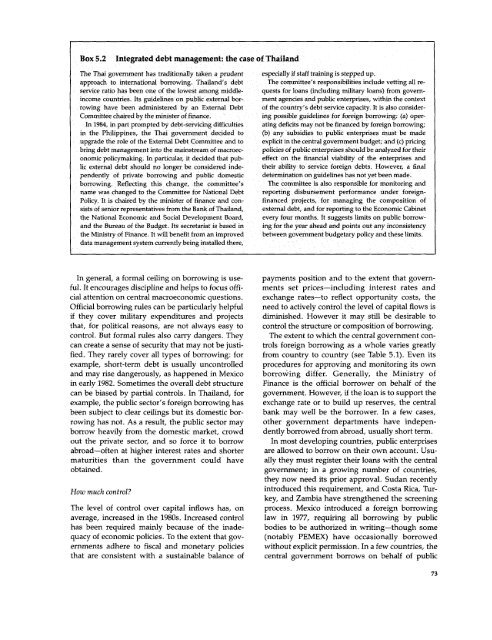World Bank Document
World Bank Document
World Bank Document
Create successful ePaper yourself
Turn your PDF publications into a flip-book with our unique Google optimized e-Paper software.
Box 5.2 Integrated debt management: the case of Thailand<br />
The Thai government has traditionally taken a prudent especially if staff training is stepped up.<br />
approach to international borrowing. Thailand's debt The committee's responsibilities include vetting all reservice<br />
ratio has been one of the lowest among middle- quests for loans (including military loans) from governincome<br />
countries. Its guidelines on public external bor- ment agencies and public enterprises, within the context<br />
rowing have been administered by an External Debt of the country's debt service capacity. It is also consider-<br />
Comrnittee chaired by the minister of finance.<br />
ing possible guidelines for foreign borrowing: (a) oper-<br />
In 1984, in part prompted by debt-servicing difficulties ating deficits may not be financed by foreign borrowing;<br />
in the Philippines, the Thai government decided to (b) any subsidies to public enterprises must be made<br />
upgrade the role of the Extemal Debt Committee and to explicit in the central government budget; and (c) pricing<br />
bring debt management into the mainstream of macroec- policies of public enterprises should be analyzed for their<br />
onomic policymaking. In particular, it decided that pub- effect on the financial viability of the enterprises and<br />
lic external debt should no longer be considered inde- their ability to service foreign debts. However, a final<br />
pendently of private borrowing and public domestic determination on guidelines has not yet been made.<br />
borrowing. Reflecting this change, the committee's The committee is also responsible for monitoring and<br />
name was changed to the Committee for National Debt reporting disbursement performance under foreign-<br />
Policy. It is chaired by the minister of finance and con- financed projects, for managing the composition of<br />
sists of senior representatives from the <strong>Bank</strong> of Thailand, external debt, and for reporting to the Economic Cabinet<br />
the National Economic and Social Development Board, every four months. It suggests limits on public borrowand<br />
the Bureau of the Budget. Its secretariat is based in ing for the year ahead and points out any inconsistency<br />
the Ministry of Finance. It will benefit from an improved between government budgetary policy and these limits.<br />
data management system currently being installed there,<br />
In general, a formal ceiling on borrowing is use- payments position and to the extent that governful.<br />
It encourages discipline and helps to focus offi- ments set prices-including interest rates and<br />
cial attention on central macroeconomic questions. exchange rates-to reflect opportunity costs, the<br />
Official borrowing rules can be particularly helpful need to actively control the level of capital flows is<br />
if they cover military expenditures and projects diminished. However it may still be desirable to<br />
that, for political reasons, are not always easy to control the structure or composition of borrowing.<br />
control. But formal rules also carry dangers. They The extent to which the central government concan<br />
create a sense of security that may not be justi- trols foreign borrowing as a whole varies greatly<br />
fied. They rarely cover all types of borrowing: for from country to country (see Table 5.1). Even its<br />
example, short-term debt is usually uncontrolled procedures for approving and monitoring its own<br />
and may rise dangerously, as happened in Mexico borrowing differ. Generally, the Ministry of<br />
in early 1982. Sometimes the overall debt structure Finance is the official borrower on behalf of the<br />
can be biased by partial controls. In Thailand, for government. However, if the loan is to support the<br />
example, the public sector's foreign borrowing has exchange rate or to build up reserves, the central<br />
been subject to clear ceilings but its domestic bor- bank may well be the borrower. In a few cases,<br />
rowing has not. As a result, the public sector may other government departments have indepenborrow<br />
heavily from the domestic market, crowd dently borrowed from abroad, usually short term.<br />
out the private sector, and so force it to borrow In most developing countries, public enterprises<br />
abroad-often at higher interest rates and shorter are allowed to borrow on their own account. Usumaturities<br />
than the government could have ally they must register their loans with the central<br />
obtained. government; in a growing number of countries,<br />
they now need its prior approval. Sudan recently<br />
How much control? introduced this requirement, and Costa Rica, Turkey,<br />
and Zambia have strengthened the screening<br />
The level of control over capital inflows has, on process. Mexico introduced a foreign borrowing<br />
average, increased in the 1980s. Increased control law in 1977, requiring all borrowing by public<br />
has been required mainly because of the inade- bodies to be authorized in writing-though some<br />
quacy of economic policies. To the extent that gov- (notably PEMEX) have occasionally borrowed<br />
ernments adhere to fiscal and monetary policies without explicit permission. In a few countries, the<br />
that are consistent with a sustainable balance of central government borrows on behalf of public<br />
73

















